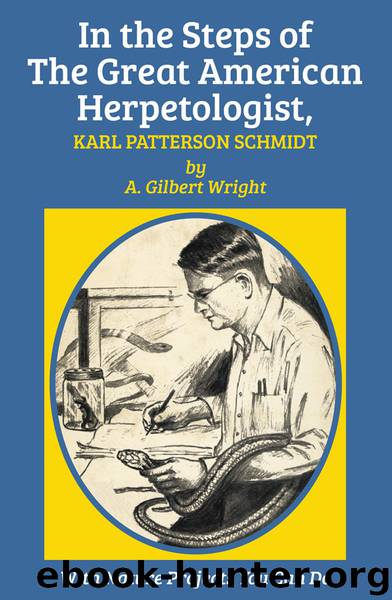In the Steps of the Great American Herpetologist, Karl Patterson Schmidt by A. Gilbert Wright

Author:A. Gilbert Wright
Language: eng
Format: epub
ISBN: 9781590773611
Publisher: M. Evans & Company
This exhibition once again extended Karl’s interest in the geographic distribution of reptiles and amphibians. As must always be the case in the observational sciences, Karl arrived at general conclusions through observation of the particular: “At night a note like isolated strokes on a tiny silver bell was heard on all sides of us. It was extremely difficult to trace, but proved to belong to a tree frog which was frequently found in the bases of the bromeliaceous air plants.”
This pinpointing of that isolated note in the rain forest of Honduras led to a further discovery—the hyla (tree frog) was engaged in laying its eggs in the water contained at the bases of the leaves of the plant. Later, in the laboratory, the hyla proved to be a previously undescribed species.
These same air plants were also found to be the home of two kinds of salamanders, one of them red and the other covered with lichen-like markings, and both kinds were again proved to be new species.
Specific observations of this sort led Karl to write, in more general terms, “It was borne upon us even in the field that we had discovered a mountain top whose animals composed a distinct fauna, isolated in the distinctive cloud-forest conditions from the same zone on other mountains by the broad river valleys to north and south. It is one of the simplest and most striking principles of species formation—and in other words of active evolution—that isolation of any kind, in insular patches of cloud-forest quite as much as on oceanic islands, is accompanied by the development of distinct forms of animals confined to such areas.”
Three years later, Karl’s second important expedition for the Field Museum, the Captain Marshall Field Expedition to Brazil, brought him still further scientific information on which to base his developing ideas about geographic distribution. On this expedition, he explored the vast marshes along the upper reaches of the Paraguay River in an area of Brazil known as the Pantanal. Here he was able to observe the huge floating mats of vegetation, known as camelotte, which were “composed principally of a coarse grass, with finger-thick stems, and two or three kinds of water hyacinth.” These mats of vegetation were carried by the current, like rafts, thousands of miles down the Paraguay River to the South Atlantic Ocean, causing the dispersion of numerous species of animals and plants all along the length of the river.
It was while he was on this expedition that Karl Schmidt began work on what was to be one of his most important projects, a translation into English, and a revision, of Richard Hesse’s Ecological Foundations of Animal Geography. There was no really adequate work in English on animal distribution, and Karl hoped to fill the gap with this book. His explorations of the extremely varied habitats of Puerto Rico; his discovery of numerous isolated species on the forested mountaintop in Honduras; and his observation of the great raft-like camelotte in Brazil had all contributed to the understanding of geographic distribution that would make this book important.
Download
This site does not store any files on its server. We only index and link to content provided by other sites. Please contact the content providers to delete copyright contents if any and email us, we'll remove relevant links or contents immediately.
The Giant and How He Humbugged America by Jim Murphy(3397)
The Science Book (Big Ideas Simply Explained) by DK(3233)
Harry Potter: A History of Magic by British Library(3003)
The Elements by Theodore Gray(3000)
A Short History of Nearly Everything by Bryson Bill(2631)
Make by Mike Westerfield(2291)
Easy Electronics by Charles Platt(2282)
The Astronomy Book by DK(2114)
The Cat in the Hat by Dr. Seuss(2109)
CLICK'D by Tamara Ireland Stone(1851)
Science Experiments You Can Eat by Vicki Cobb(1839)
Calling All Minds by Temple Grandin(1782)
Think Like a Rocket Scientist by Ozan Varol(1781)
The Crime Book (Big Ideas Simply Explained) by DK(1757)
03 The Prophet of Yonwood by Jeanne DuPrau(1753)
Minecraft by Mojang Ab(1744)
Pax by Sara Pennypacker(1725)
Martin Gardner's Science Magic by Martin Gardner(1689)
Getting Started with Soldering: A Hands-On Guide to Making Electrical and Mechanical Connections by Vinck Marc de(1661)
